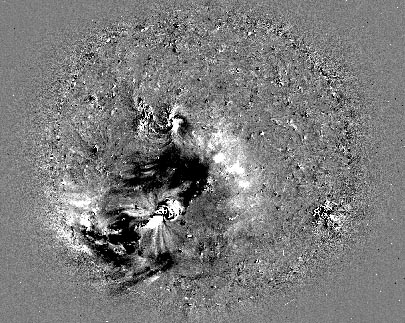Explanation: The Earth has once again endured a burst of particles from the Sun. The latest storm, which began Monday, was one of the best documented solar storms to date. At 10 am (EDT) ground monitors of the SOHO spacecraft, which continually monitors the Sun, noticed a weak spot in the solar corona was buckling again, this time letting loose a large, explosive Coronal Mass Ejection (CME). Almost simultaneously, NASA's WIND spacecraft began detecting bursts of radio waves from electrons involved in this magnetic storm. Supersonic waves rippled though the solar corona as a puff of high energy gas shot out into the Solar System. The above image shows two photographs of the Sun taken about 15 minutes apart and subtracted, highlighting the explosion. The CME gas will have little lasting effect on the Earth, but might make this a good weekend to see an aurora.
1999 2000 2001 2002 2003 2004 2005 2006 2007 2008 2009 2010 2011 2012 2013 2014 2015 2016 2017 2018 2019 2020 2021 2022 2023 2024 2025 |
Январь Февраль Март Апрель Май Июнь Июль Август Сентябрь Октябрь Ноябрь Декабрь |
NASA Web Site Statements, Warnings, and Disclaimers
NASA Official: Jay Norris. Specific rights apply.
A service of: LHEA at NASA / GSFC
& Michigan Tech. U.
|
Публикации с ключевыми словами:
Sun - корональный выброс - Солнечная вспышка - Солнечная корона - полярное сияние
Публикации со словами: Sun - корональный выброс - Солнечная вспышка - Солнечная корона - полярное сияние | |
См. также:
Все публикации на ту же тему >> | |
